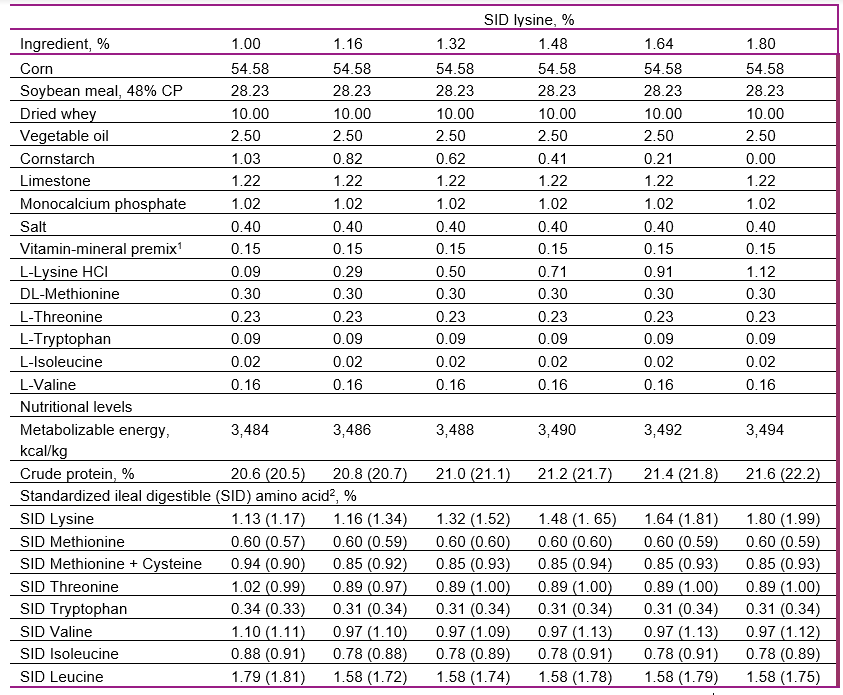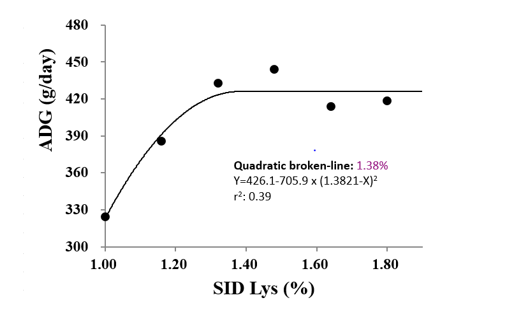



A new study on standardized ileal digestible lysine requirement for high lean weanling pigs confirms the industry recommendations
The mean standardized ileal digestible (SID) lysine requirement for 7-15 kg weanling pigs of the high-lean genetic line, fed corn-soybean meal-based diets to optimize body weight gain and gain:feed is 1.42%. This is the conclusion of a study conducted at the experimental pig farm of the University of Manitoba, Canada.Lysine is typically the first-limiting amino acid (AA) in corn-soybean meal-based swine diets (NRC, 2012). According to the NRC (2012), the SID lysine requirement is 1.35% for 7-11 kg pigs. There have been several experiments evaluating the SID lysine requirement for weanling pigs in the last few years (Nemechek et al., 2012; Jones et al., 2014; Park and Kim, 2015; Kahindi et al., 2017). The SID lysine requirement estimates range from 1.32 to 1.54%. This discrepancy is attributable to factors such as genetic ability for protein deposition (Hansen et al., 1997; Schneider et al., 2010), sanitary condition of experimental environment (Kahindi et al., 2014; Jayaraman et al., 2015, 2017), or different statistical methods used for data analysis (Nemechek et al., 2012; Park and Kim, 2015).
Although the lysine requirement for piglets has been determined (NRC, 2012), it is important to keep verifying the AA requirements for various stages especially for weanling pigs. It is understood that no study has been performed to determine the SID lysine requirement for Topigs’ recently developed pig genotype (TN Tempo × TN70) that was bred for greater efficiency of body weight gain and robustness.
Experimental design
A group of 144 pigs (initial body weight = 6.51 ± 0.56 kg) were weaned at 21 days of age and assigned to one of 6 dietary treatments with increasing concentrations of SID lysine from 1.00 to 1.80% achieved by adding crystalline
L-Lys·HCl at the expense of cornstarch (Table 1). Feed ingredients were analyzed prior to feed formulation. Diets were isoaminoacidic (except lysine) and formulated to meet the requirements of Evonik (AMINOPig 1.0). Pigs were allotted to dietary treatments with 8 replicate pens/treatment, consisting of 3 pigs/pen (4 replicates per each sex).
The pigs were fed experimental diets in mash form for 21 days with free access to feed and water. Feed intake and body weight were recorded weekly to calculate average daily gain (ADG), average daily feed intake (ADFI), and gain to feed ratio (G:F). Pigs were fasted overnight to collect blood samples at days 0, 14, and 21 from the pigs with the closest body weight (BW) to the mean of each pen to analyze plasma urea nitrogen (PUN).
Orthogonal polynomial contrasts were used to test the linear and quadratic effects of dietary SID lysine concentration. The SID lysine requirement was estimated with all replicates using linear broken-line, quadratic broken-line, and quadratic model using NLIN procedure of SAS (Robbins et al., 2006) but the quadratic broken-line model being best fit model was selected.

1 Provided the following nutrients (per kg of diet): Vitamins: A, 2200 IU; D3, 220 IU; E, 16 IU; K, 0.5 mg; B1, 1 mg; B2, 3.5 mg; B6, 7 mg; B12, 17.5 µg; calcium pantothenate, 10 mg; folic acid, 0.3 mg; niacin, 30 mg; biotin, 50 µg. Minerals: Cu, 6 mg (as copper sulfate); I, 0.14 mg (as calcium iodate); Fe, 100 mg (as ferrous sulfate); Mn, 4 mg (as manganese oxide); Se, 0.3 mg (as sodium selenite); Zn, 100 mg (as zinc oxide).
2 Values in parenthesis are analyzed values expressed in total content.
Results and discussion
There were no significant differences between sex for any parameter across all phases. Also, no differences were observed among treatments for the first week of the trial in ADG and ADFI. However, G:F ratio showed a quadratic increment (P < 0.05) when SID lysine concentration increased in the diets. From days 7 to 14, a quadratic increase (P < 0.05) was observed in ADG and ADFI and a linear increase (P < 0.05) of G:F of weanling pigs as dietary SID lysine concentration increased. During the last week, from days 14 to 21, it was observed a quadric increase (P < 0.05) in ADG and G:F, but only a trend (P = 0.09) to increase ADFI by increasing levels of SID lysine.

a-b Values in a row with different letters are different (P < 0.05).
During the overall period, increasing dietary SID lysine increased the final body weight, ADG and G:F linearly and quadratically (Table 2). The ADG for pigs fed the 1.48% SID lysine diet was 36% greater compared to pigs fed the lowest (1%) SID lysine diet. Also, pigs fed the 1.48% SID lysine diet showed 21% higher G:F compared to those fed the lowest (1.00%) SID lysine diet. This positive relationship between ADG or G:F and dietary lysine concentration in growing pigs has been observed in previous experiments (Coma et al., 1995; Kendall et al., 2008; Moore et al., 2012).
The PUN concentration was similar across treatments at day 0, whereas at days 14 and 21 PUN decreased linearly and quadratically (P < 0.05) as the SID lysine level increased (Table 2). Plasma urea nitrogen is used as an indicator of protein utilization and thus, its concentration indicates the utilization of AA either for anabolic or catabolic purposes (Coma et al., 1995). As observed in this study, PUN concentration declines as the dietary lysine intake increases up to a point where lysine requirement is met indicating a more efficient utilization of the AA.


Using the values for ADG observed over the overall experimental period, the SID lysine requirement was estimated at 1.38% using the quadratic broken-line model (Figure 1). For the overall G:F, the quadratic broken-line model estimated the optimal level of SID lysine to be 1.46% (Figure 2). This results a mean SID lysine requirement of 1.42% for the 7-15 kg weanling pigs of high lean genetic which is higher than the value of 1.35% SID lysine requirement suggested by NRC (2012), but it is in line with the recommendations of Topigs (1.34-1.39% SID Lys) and Evonik (1.37%) to optimize growth performance.









